Pump Handbook by Igor J. Karassik, Joseph P. Messina, Paul Cooper, Charles C. Heald - 3rd edition
Подождите немного. Документ загружается.

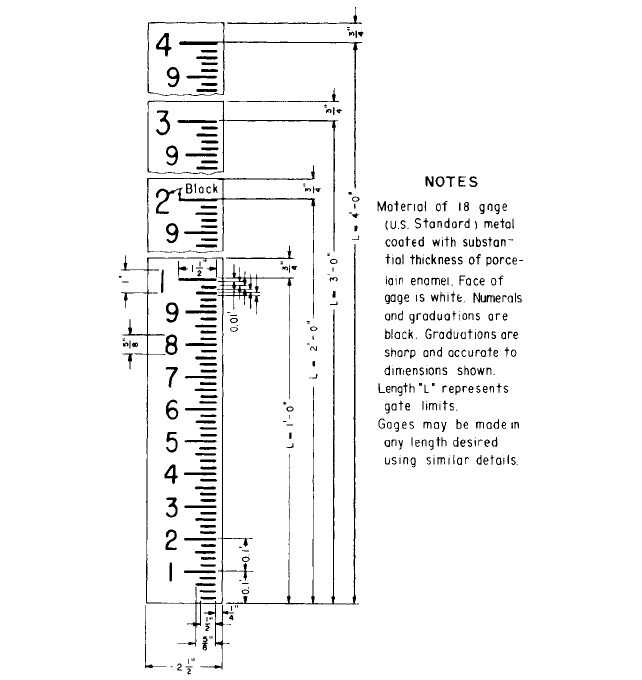
13 PUMP TESTING 13.21
FIGURE 15 Standard weir, or staff, gage
head H in feet (meters) and the crest length L in feet (meters). The discharge of the stan-
dard 90° V-notch weir is determined directly by the head on the bottom of the V notch.
As the stream passes over the weir, the top surface curves downward. This curved sur-
face, or drawdown, extends upstream a short distance from the weir notch. The head H
must be measured at a point on the water surface in the weir pond beyond the effect of the
drawdown.This distance should be at least four times the maximum head on the weir, and
the same gage point should be used for lesser discharges. A staff gage (Figure 15) having
a graduated scele with the zero placed at the same elevation as the weir crest is usually
provided for the head measurements.
Two widely used sets of formulas for computing discharge over standard contracted
rectangular weirs are those of Smith
4
and Francis.
5
The formulas proposed by Smith
require the use of coefficients of discharge that vary with the head of water on the weir
and with the length of the weir. Consequently, the Smith formulas are somewhat incon-
venient to use, although they are accurate for the ranges of coefficients usually given. For
this type of weir operating under favorable conditions as prescribed in preceding para-
graphs, the Francis formula when velocity of approach is neglected is

13.22 CHAPTER THIRTEEN
in USCS units (1)
in SI units
and the formula when velocity of approach is included is
in USCS units
in SI units (2)
where Q discharge neglecting velocity of approach, ft
3
/s (m
3
/s)
Q¿ discharge considering velocity of approach, ft
3
/s (m
3
/s)
H head on weir, ft (m)
L length of weir, ft (m)
h head due to velocity of approach (v
2
/2g), ft (m)
Note that the Francis formulas contain constant discharge coefficients that allow com-
putation without the use of tables. A table of powers that provides values of H
3/2
,h
3/2
,
and (H h)
3/2
for convenience in computing discharge with the Francis formulas may be
found in hydraulic handbooks.
The principal formulas used for computing the discharge of the standard suppressed
rectangular weir were also proposed by Smith and Francis. In the Smith formulas for sup-
pressed weirs, as for contracted weirs, coefficients of discharge vary with weir head and
length; therefore, these formulas are not convenient for use in computations without
tables or coefficients.
The Francis formula for the standard suppressed rectangular weir neglecting velocity
of approach in
in USCS units
in SI units (3)
and that including velocity of approach is
in USCS units
in SI units (4)
In these formulas, the letters have the same significance as in the formulas for con-
tracted rectangular weirs. The coefficient of discharge was obtained by Francis from the
same general set of experiments as those used for the contracted rectangular weir. No
tests have been made to determine the applicability of these formulas to weirs less than
4 ft (1.2 m) in length.
The Cipolletti weir is a contracted weir and must be installed as such to obtain rea-
sonably correct and consistent discharge measurements. However, Cipolletti has compen-
sated for the reduction in discharge due to end contractions by sloping the sides of the weir
sufficiently to overcome the effect of contraction. The Cipolletti formula, in which the Fran-
cis coefficient is increased by about 1% and velocity of approach is neglected, is
in USCS units (5)
in SI units
The formula including velocity of approach is
in USCS units (6)
in SI units
where Q discharge neglecting velocity of approach, ft
3
/s (m
3
/s)
Q¿ discharge considering velocity of approach, ft
3
/s (m
3
/s)
Q¿ 1.858L1H 1.5h2
3>2
Q¿ 3.367L1H 1.5h2
3>2
Q 1.858LH
3>2
Q 3.367LH
3>2
Q¿ 1.837L31H h2
3>2
h
3>2
4
Q¿ 3.33L31H h2
3>2
h
3>2
4
Q 1.857LH
3>2
Q 3.33LH
3>2
3
2
Q¿ 1.83731H h2
3>2
h
3>2
21L 0.2H2
Q¿ 3.3331H h2
3>2
h
3>2
41L 0.2H2
Q 1.837H
3>2
1L 0.2H2
Q 3.33H
3>2
1L 0.2H2
13 PUMP TESTING 13.23
H head on weir, ft (m)
L length of weir, ft (m)
h head due to velocity of approach (v
2
/2g), ft (m)
The accuracy of measurements obtained with Cipolletti weirs and these formulas is
inherently not as great as that obtained with suppressed rectangular or V-notch weirs.
6
It
is, however, acceptable where no great precision is required.
There are several well-known formulas used to compute the discharge over 90° V-notch
weirs. The most commonly used in the field of irrigation are the Cone formula and the
Thomson formula. The Cone formula, considered by authorities to be more reliable for
small weirs and for conditions generally encountered in measuring water for open chan-
nels, is
in USCS units
in SI units (7)
where Q discharge over weir, ft
3
/s (m
3
/s)
H head on weir, ft (m)
Ordinarily V-notch weirs are not appreciably affected by velocity of approach. If the
weir is installed with complete contraction, the velocity of approach will be low.
Flumes have a measuring section that is produced by contraction of the channel side-
walls or by raising of the bottom to form a hump, or by both.The Parshall flume
7
is the most
common and best known measuring flume, especially in irrigation canals. It is a specially
shaped open-channel flow section that may be installed in a canal, lateral, or ditch to mea-
sure the rate of flow of water. The flume has four significant advantages: (1) it can operate
with relatively small head loss, (2) it is relatively insensitive to velocity of approach, (3) it
has the capability of making good measurements with no submergence, moderate submer-
gence, or even with considerable submergence downstream, and (4) its velocity of flow is suf-
ficiently high to virtually eliminate sediment deposition in the structure during operation.
Discharge through a Parshall flume can occur for two conditions of flow. The first, free
flow, occurs when there is insufficient backwater depth to reduce the discharge rate. The
second, submerged flow, occurs when the water surface downstream from the flume is far
enough above the elevation of the flume crest to reduce the discharge. For free flow, only
the flume head H
a
at the upstream gage location is needed to determine the discharge
from a standard table. The free-flow range includes some of the range that might ordi-
narily be considered submerged flow because Parshall flumes tolerate 50 to 80% submer-
gence before the free-flow rate is measurably reduced. For submerged flows (when
submergence is greater than 50 to 80%, depending upon flume size), both the upstream
and downstream heads H
a
and H
b
are needed to determine the discharge (Figure 16).
A distinct advantage of the Parshall flume is its ability to function as a flowmeter over
a wide operating range with minimum head loss while requiring but a single head mea-
surement for each discharge. The head loss is only about one-fourth of that needed to oper-
ate a weir having the same crest length. Another advantage is that the velocity of
approach is automatically controlled if the correct size of flume is chosen and if the flume
is used as it should be, that is, as an in-line structure.
Flumes are widely used because there is no easy way to alter the dimensions of flumes
that have been constructed or to change the device or channel to obtain an unfair propor-
tion of water.
The main disadvantages of Parshall flumes are (1) they cannot be used in close-coupled
combination structures consisting of turnout, control, and measuring device; (2) they are
usually more expensive than weirs or submerged orifices; (3) they require a solid, water-
tight foundation; and (4) they require accurate workmanship for satisfactory construction
and performance.
Parshall flume sizes are designated by the throat width W, and sizes range from 1 in
(25.4 mm) for discharges as small as 0.01 ft
3
/s (2.83 10
2
m
3
/s) up to 50 ft (15 m) for dis-
charges as large as 3000 ft
3
/s (85 m
3
/s).
8
Flumes may be built of wood, concrete, galvanized
Q 1.34H
2.48
Q 2.49H
2.48
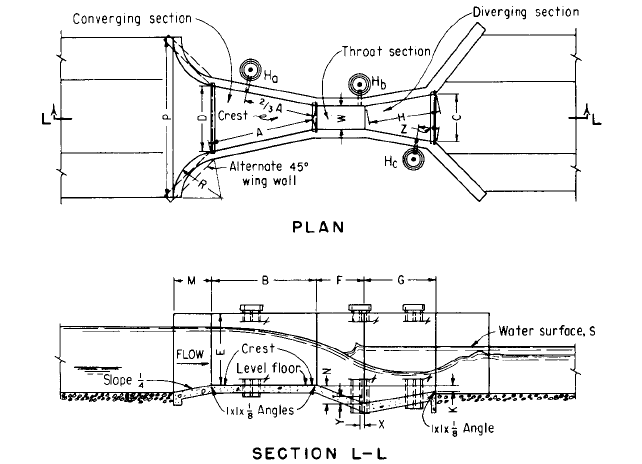
13.24 CHAPTER THIRTEEN
FIGURE 16A Parshall flume dimensions (sheet 1 of 2)
sheet metal, or other desired materials. Large flumes are usually constructed on the site,
but smaller flumes may be purchased as prefabricated structures to be installed in one
piece. Some flumes are available as lightweight shells, which are made rigid and immobile
by placing concrete outside the walls and beneath the bottom. Larger flumes are used in
rivers and large canals and streams; smaller ones are used for measuring farm deliveries
or for row requirements in the farmer’s field.
Flumes can operate in two modes: free flow and submerged flow. In free flow, the dis-
charge depends solely upon the width of the throat W and the depth of water H
a
at the
gage point in the converging section (Figures 16 and 17). Free-flow conditions in the flume
are similar to those that occur at a weir or spillway crest in that water passing over the
crest is not slowed by downstream conditions.
In submerged flow, other factors are operative. In most installations, when the dis-
charge is increased above a critical value, the resistance to flow in the downstream chan-
nel becomes sufficient to reduce the velocity, increase the flow depth, and cause a
backwater effect at the Parshall flume. It might be expected that the discharge would
begin to be reduced as soon as the backwater level H
b
exceeds the elevation of the flume
crest; however, this is not the case. Calibration tests show that the discharge is not
reduced until the submergence ratio H
b
/H
a
(expressed in percent) exceeds the following
values:
50% for flumes 1, 2, and 3 in (25, 50, and 75 mm) wide
60% for flumes 6 and 9 in (152 and 229 mm) wide
70% for flumes 1 to 8 ft (0.3 to 2.4 m) wide
80% for flumes 8 to 50 ft (2.4 to 15.2 m) wide
The discharge equations for free flow over flumes are as follows. The equation which
expresses the relationship between upstream head H
a
and discharge Q for widths W from
1 to 8 ft (0.3 to 2.4 m) is
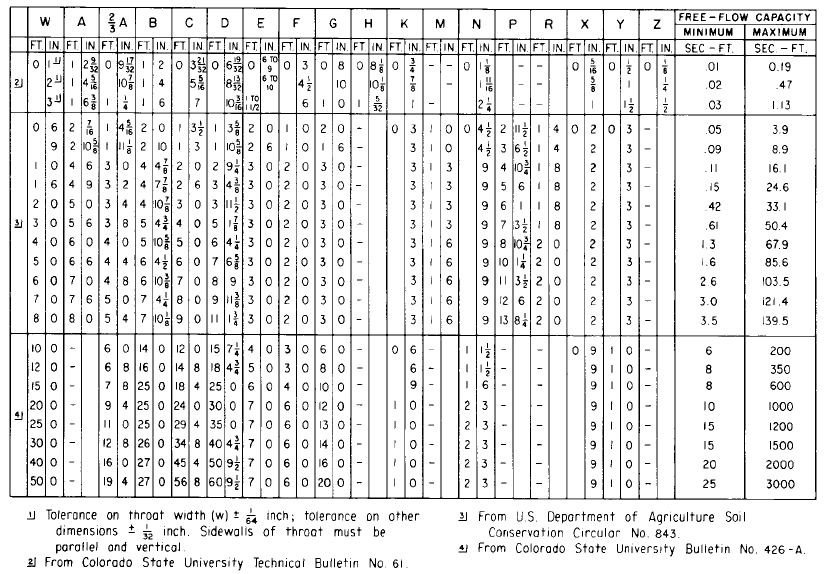
13.25
FIGURE 16B Parshall flume dimensions (sheet 2 of 2.) (1 ft = 0.3048 m;
ft
3
/s = 0.0253 m
3
/s)
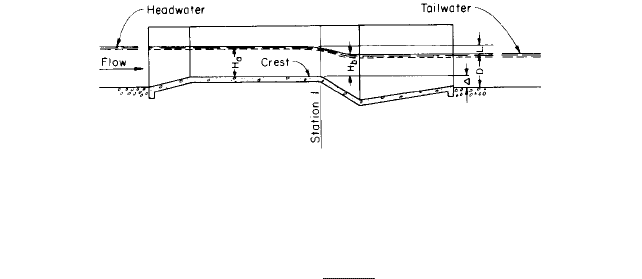
13.26 CHAPTER THIRTEEN
FIGURE 17 Relationships of flow depth to flume crest elevation
in USCS units
in SI units
If this equation is used to compute discharges through flumes ranging from 10 to 50 ft
(3 to 15.7 m) wide, the computed discharges are always larger than actual discharges.
Therefore, a more accurate equation was developed for the large flumes:
In USCS units
In SI units
This difference in computed discharges obtained by using the two equations for an 8-ft
(2.4-m) flume is normally less than 1%; however, the difference becomes greater as the
flume size increases. Because of the difficulties in regularly using these equations, dis-
charge tables have been prepared for use with flumes 1 to 50 ft (0.3 to 15.2 m) wide.
CURRENT METERS The essential features of a conventional current meter are a wheel that
rotates when immersed in flowing water and a device for determining the number of rev-
olutions of the wheel. For open-channel flow measurement, a type generally used is the
Price meter with five or six conical cups.The relationship between the velocity of the water
and the number of revolutions of the wheel per unit time is determined experimentally
for each instrument for various velocities. Also, the operator must have considerable skill
to obtain consistent satisfactory results.
A detailed explanation of the use of current meters is contained in Chapter 5 of Ref-
erence 9.
OTHER METHODS The discharge measurement methods previously given are the ones in
common use; however, a number of other methods, some newer and more sophisticated,
are well established. The use of these special methods is acceptable provided their limi-
tations are recognized and all parties to the testing program are in agreement on their
use. A few of these methods, not in any particular order, are
Salt velocity Deflection meters Radioisotope Color dilution
Salt dilution Propeller meters Gates and sluices Slope area
Color velocity Float movement Acoustic flowmeters
FIELD APPROXIMATING Often a field approximation of water flow from a pump discharge
becomes necessary, especially if no other methods are practical or readily available. One
of the accepted methods is by trajectory. The discharge from the pipe may be either ver-
tical or horizontal, the principal difficulty being in measuring the coordinates of the flow-
ing stream accurately. The pipes must be flowing full, and the accuracy of this method
varies from 85 to 100%. Figure 18 illustrates the approximation from a horizontal pipe.
This method can be further simplified by measuring to the top of the flowing stream and
Q 12.293W 0.4742H
a
1.6
Q 13.6875W 2.52H
a
1.6
Q 0.371W a
Ha
0.305
b
1.57W
0.026
Q 4WH
a
1.522W
0.026
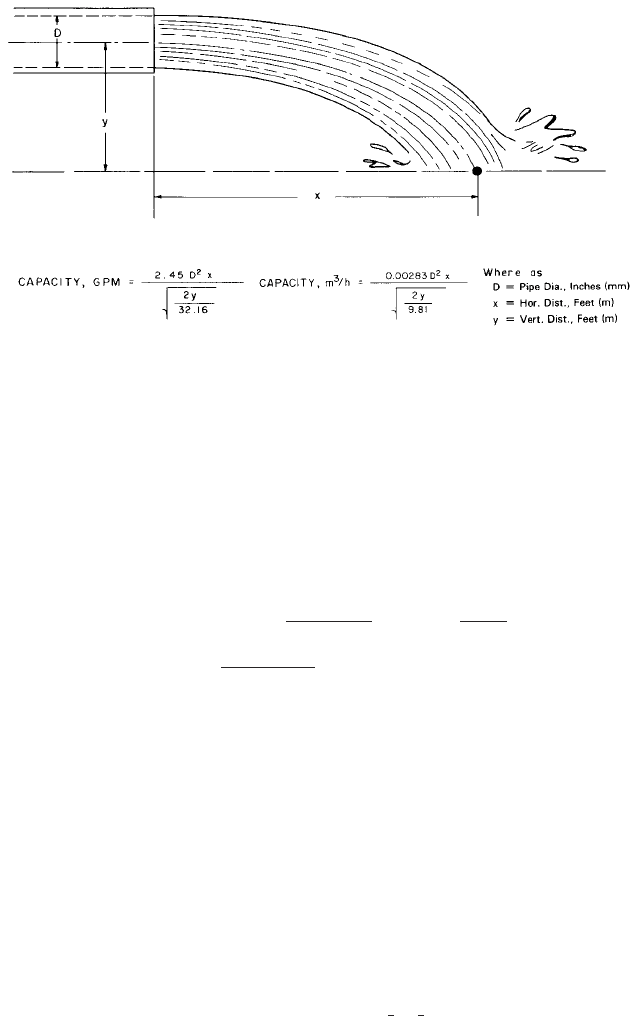
13 PUMP TESTING 13.27
FIGURE 18 Approximating flow from a horizontal pipe
always measuring so y equals 12 in (300 mm) and measuring the horizontal distance X
in inches (millimeters), as illustrated in Figure 19.
Figure 20 illustrates a method of measuring discharge from a vertical pipe.
Head Measurements Head is the quantity used to express the energy content of a liq-
uid per unit weight of the liquid referred to any arbitrary datum. In terms of foot-pounds
of energy per pound of liquid, all head quantities have the dimensions of feet of liquid.
The unit for measuring head is the foot (meter). The relation between a pressure
expressed in pounds per square inch (kilopascals) and one expressed in feet (meters) of
head is
in USCS units
in SI units
where specific weight (mass), lb/ft
3
(kg/l)
sp. gr. specific gravity of the liquid
The following exerpt from the Hydraulic Institute Standard is used by the Bureau of
Reclamation throughout its test program:
It is important that steady flow conditions exist at the point of instrument connec-
tion. For this reason, it is necessary that pressure or head measurement be taken on
a section of pipe where the cross section is constant and straight. Five to ten diame-
ters of straight pipe of unvarying cross section following any elbow or curved mem-
ber, valve, or other obstruction, are necessary to insure steady flow conditions.
The following precautions should be taken in forming orifices for pressure-
measuring instruments and for making connections. The orifice in the pipe should be
flush with and normal to the wall of the water passage. The wall of the water passage
should be smooth and of unvarying cross section. For a distance of at least 12 in (0.8 m)
preceding the orifice, all tubercles and roughness should be removed with a file or
emery cloth, if necessary. The orifice should be from to in (3–6 mm) in diameter and
two diameters long.
1
4
1
8
Head, m
0.102 kPa
W
Head, ft lb>in
2
2.31 62.3
W
lb>in
2
2.31
sp. gr.
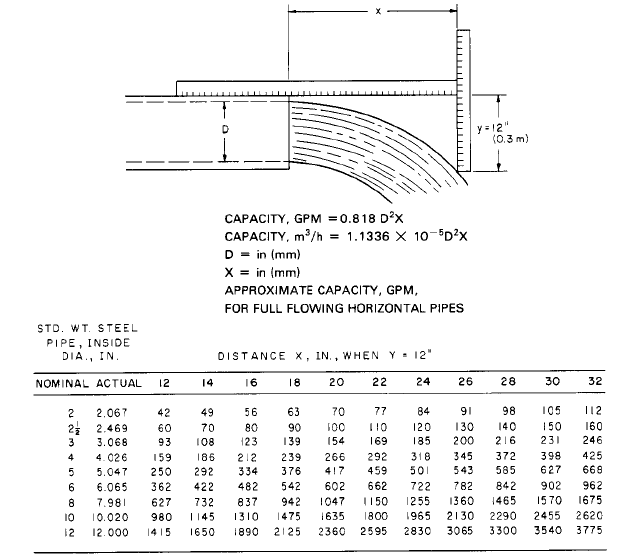
13.28 CHAPTER THIRTEEN
FIGURE 19 Simplified method for approximating flow from a horizontal pipe (1 in = 25.4 mm; 1 gpm = 0.227
m
3
/h).
The edges of the orifice should be provided with a suitable radius tangential to the
wall of the water passage and should be free from burrs or irregularities. Two pressure
tap arrangements shown in Figure 27 indicate taps in conformity with the above.
Where more than one tap is required at a given measuring section, separate properly
valved connections should be made. As an alternative, separate instruments should be
provided.
Multiple orifices should not be connected to one instrument except on those metering
devices, such as venturi meters, where proper calibrations have been made.
All leads from the orifice should be tight and as short and direct as possible. For dry-tube
leads, suitable drain pots should be provided and a loop of sufficient height to keep the
pumped liquid from entering the leads should be formed. For wet-tube leads, vent cocks for
flushing should be provided at any high point or loop crest to assure that tubes do not become
airbound. All instrument hose, piping, and fittings should be checked under pressure prior
to test to assure that there are no leaks. Suitable damping devices may be used in the leads.
If these conditions cannot be satisfied at the point of measurement, it is recommended
that four separate pressure taps be installed, equally spaced about the pipe, and that the
pressure at that section be taken as the average of the four separate values. If the separate
readings show a difference of static pressure that might affect the head beyond the contract
tolerances, the installation should be corrected or an acceptable tolerance determined.
Figures 21 to 27 show suitable arrangements for various types of instruments and for-
mulas for translating instrument readings into feet (meters) of liquid pumped, for express-
ing instrument head as elevation over a common datum, and for correcting these formulas
for the velocity head existing in the suction and discharge pipes.
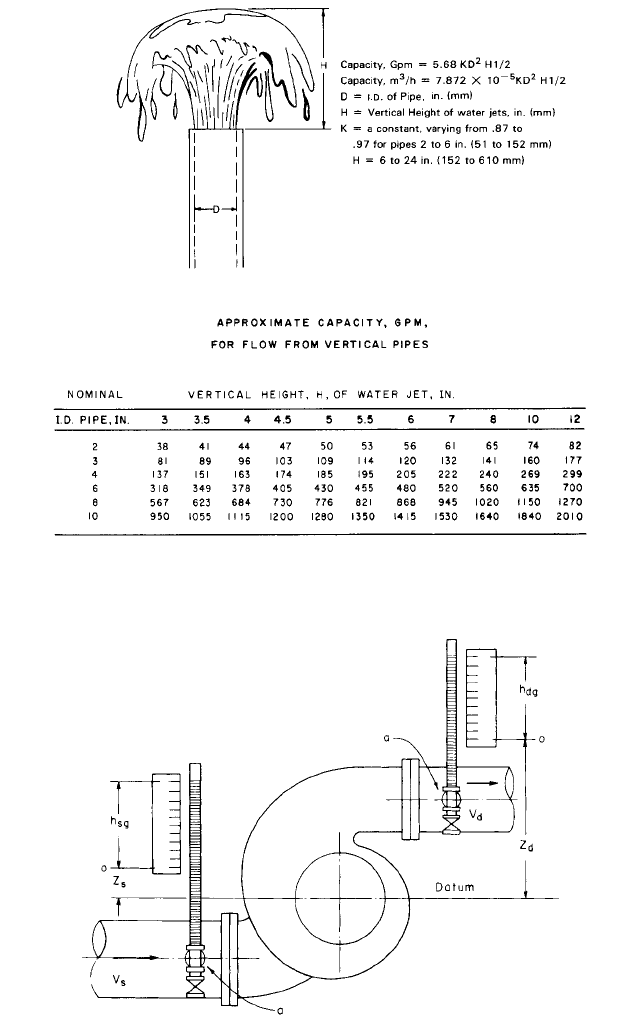
13 PUMP TESTING 13.29
FIGURE 20 Approximating flow from a vertical pipe (1 in = 25.4 mm; 1 gpm = 0.227 m
3
/h)
FIGURE 21 Head measurement
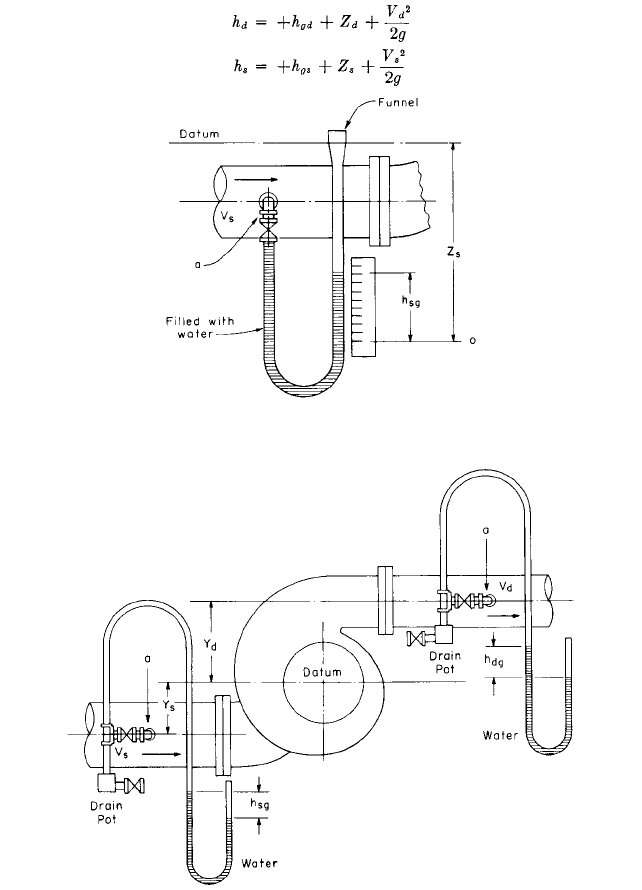
13.30 CHAPTER THIRTEEN
FIGURE 22 Head measurement
FIGURE 23 Head measurement
The datum is taken as the centerline of the pump for horizontal-shaft pumps and as
the entrance eye of the impeller for vertical-shaft pumps.
The instruments, when practicable, are water columns or manometers for normal pres-
sures and mercury manometers, bourdon gages, electric pressure transducers, or dead-
weight gage testers for high pressure.When water columns are used, care should be taken
